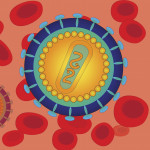Intensifying antiretroviral therapy (ART) by adding dolutegravir and maraviroc did not improve neurocognitive function in people with HIV who were already taking a suppressive regimen, according to study results reported in Clinical Infectious Diseases.
Serious cognitive dysfunction among people living with HIV—known as HIV-associated neurocognitive disorder (HAND)—is much less common now than it was before the advent of effective antiretroviral treatment in the mid-1990s. But many HIV-positive people still experience more subtle impairment of thinking, attention and memory. Estimates of the prevalence of neurocognitive impairment are as high as 50%.
Even when people on treatment achieve an undetectable viral load according to blood tests, HIV can still persist—and potentially continue to replicate—in various reservoir sites in the body, including the brain. Some antiretrovirals do not cross the blood-brain barrier, which protects the brain from certain pathogens and toxins, including many drugs. Chronic inflammation, drug toxicity and irreversible brain injury that occurred prior to treatment may also contribute to neurocognitive impairment even when people are on suppressive ART.
Over the years, researchers have explored whether intensifying treatment, especially by adding antiretrovirals known to cross the blood-brain barrier, can help improve neurocognitive function, but results have been mixed and largely discouraging. The latest findings do not change this assessment.
Scott Letendre, MD, of the University of California San Diego, and colleagues conducted a randomized, double-blind, placebo-controlled trial (ACTG A5324) of ART intensification in people who were currently on treatment with viral suppression. The researchers screened 357 people and enrolled 191 participants. More than 70% were men, half were Black, about a quarter each were white and Latino and the average age was 52 years.
All participants had some degree of neurocognitive impairment at baseline. Nearly two thirds met the criteria for symptomatic HIV-associated neurocognitive disorder, while the rest had subtler impairment apparent on cognitive tests.
All were on ART with a plasma viral load below 50. The most commonly used antiretrovirals were emtricitabine (83%), tenofovir disoproxil fumarate (TDF; 63%), efavirenz (32%), tenofovir alafenamide (TAF; 27%) and darunavir (24%). The most common regimens were Atripla (efavirenz/TDF/emtricitabine), Odefsey (rilpivirine/TAF/emtricitabine) and ritonavir-boosted darunavir plus TDF/emtricitabine.
The mean CD4 T cell count at baseline was high, at approximately 700 cells, but a third had fallen below 100 cells in the past, indicating severe immune suppression. Comorbidities were common—averaging four per person—including hypertension, elevated blood lipids, asthma, osteoarthritis and type 2 diabetes. Many were taking medications for conditions other than HIV.
Study participants were randomly assigned to intensify treatment by adding dolutegravir plus maraviroc, dolutegravir plus a placebo or two placebos to their current regimen. Dolutegravir (sold alone as Tivicay) was chosen because it reaches therapeutic levels in the cerebrospinal fluid (CSF) surrounding the brain and spinal cord, and because it is reliably effective in people who have not previously taken integrase inhibitors. Maraviroc (Selzentry), too, also chosen because it reaches therapeutic concentrations in the CSF. What’s more, the drug, which blocks HIV from entering cells using the CCR5 coreceptor, also has anti-inflammatory properties. Some studies have shown that inhibition of CCR5 may decrease migration of lymphocytes into the central nervous system, the study authors noted.
Despite taking more drugs, treatment intensification was generally well tolerated. Only 15 people (8%) discontinued therapy due to adverse events, a rate that did not differ significantly between the three groups.
But adding the drugs did not have a notable effect in neurocognitive function. Total neurocognitive z-scores (a standardized measure of variation from a group average), depressive symptoms and daily functioning improved over time in all arms, but there were no significant differences between the groups at 48, 72 or 96 weeks. Verbal memory and verbal learning scores did improve more in the group that added both dolutegravir and maraviroc. That group also saw larger increases in CD4 and CD8 cells, though the ratio did not change. These results were consistent when participants were stratified by severity of baseline neurocognitive impairment, lowest-ever CD4 count, age, sex and level of education.
The researchers also noted that adding dolutegravir did not adversely affect cognition, mood or weight. Several studies have found that people who start integrase inhibitors are prone to weight gain, but in this trial, while body mass index increased modestly over 96 weeks, there was no difference between those who added dolutegravir and those who did not.
“This is the largest, randomized, placebo-controlled trial of ART intensification for neurocognitive impairment in people with HIV,” the study authors concluded. “The findings do not support empiric ART intensification as a treatment for neurocognitive impairment in people with HIV on suppressive ART.”
“These findings provide strong evidence that ART intensification with currently available ART drugs is not an effective strategy to treat existing neurocognitive impairment in people with HIV who are already taking suppressive therapy,” they wrote in their discussion of the results.
“Instead, the negative findings support alternative explanations, such as prior central nervous system injury, cellular shedding of viral products, persistent inflammation or comorbid disease,” they continued. They noted that ART intensification would not necessarily reduce shedding of neurotoxic viral products, such as HIV proteins or genetic material, from transcriptionally active cells in the central nervous system any more than an existing suppressive regimen would.
Click here for more news about HIV and cognitive function.







1 Comment
1 Comment